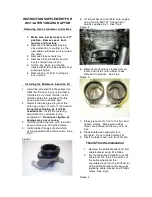
100-00-23
General Information
100-00-23
DESCRIPTION AND OPERATION
E853 EN
02/2001 2002 Bantam
Road/Roller Testing
Road or roller testing may be carried out for various
reasons and a procedure detailing pre-test checks,
through engine starting and stopping, pre-driving
checks, on-test checks to final checks on completion
of the test is given overleaf.
Unless complete vehicle performance is being
checked, the full road test procedure need not be
carried out. Instead, those items particularly relevant
to the system/s being checked can be extracted.
Pre-Test Checks
WARNING: If the brake system hydraulic fluid
level is low, pedal travel is excessive or a
hydraulic leak is found, do not attempt to
road test the vehicle until the reason for the
low fluid level, excessive pedal travel or
hydraulic leak is found and rectified.
It is suggested that pre-test checks, and functional
tests of those systems/circuits which affect the safe
and legal operations of the vehicle, such as brakes,
lights and steering, should always be carried out
before the road or roller test.
• Engine oil level
• Engine coolant level
• Tires, for correct pressure, compatible types and
tread patterns, and wear within limits.
• There is sufficient fuel in the tank to complete the
test.
• All around the engine, transmission and under the
vehicle for oil, coolant, hydraulic and fuel leaks.
Make a note of any apparent leaks and wipe off
the surrounding areas to make it easier to identify
the extent of the leak on completion of the test.
Starting the Engine
NOTE:
On initial drive away from cold and within the
first 1.5 km (1 mile), do not depress accelerator pedal
beyond half travel until the vehicle has attained a
minimum speed of 25 km/h (15 miles/h). Never
operate at high engine speed or with the accelerator
pedal at full travel whilst the engine is cold.
With the ignition switched off, check:
• The handbrake is applied.
• The gear lever is in neutral.
• All instrument gauges (except fuel gauge) read
zero.
With the ignition switched on, check:
• Ignition controlled warning lights come on.
• Engine temperature gauge registers a reading
compatible with the engine temperature.
• Fuel gauge registers a reading appropriate to the
fuel level in the tank.
• The operation of the handbrake warning light and
fluid level warning indicator light.
On Road or Roller Test Check:
CAUTION: If road testing, check the brake
operation while still travelling at low speed
before continuing with the test. If the brakes
pull to one side, or appear to be otherwise
faulty, do not continue with the road test until
the fault has been found and rectified.
• Clutch pedal operation is not stiff or heavy.
• Initial gear engagement is smooth and there is no
evidence of clutch drag.
• Handbrake control operates smoothly and the
handbrake releases quickly and completely.
• Clutch takes up the drive smoothly, without slip or
judder.
• Gear changing is smooth, and there are no
abnormal noises or vibrations from the
transmission.
• The engine power output is satisfactory, full power
is achieved, acceleration is smooth and pedal
operation not stiff or heavy, and engine speed
returns to idle correctly.
• There is no excessive or abnormally colored
smoke from the engine under normal driving,
heavy load or overrun conditions.
• Steering operation, including power steering
where fitted, is smooth, accurate, not excessively
heavy or with excessive free play or vibration.
Does not pull to one side and self centres
smoothly after cornering.
• Speedometer, oil pressure warning lamp, coolant
temperature gauge and tachometer (where fitted)
register the correct readings or operate correctly.
• Switches and controls operate smoothly and
positively, warning or indicator lights operate
correctly and the direction indicator control self
cancels when the steering is returned to the
straight ahead position.
• Heating and ventilation systems work correctly
and effectively.
• Brake operation and efficiency.
















































